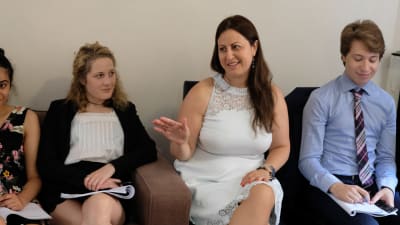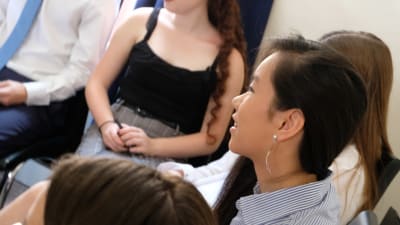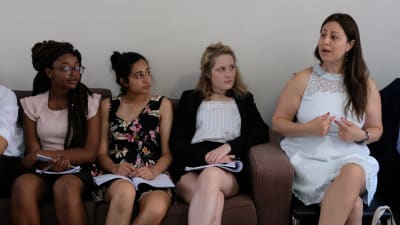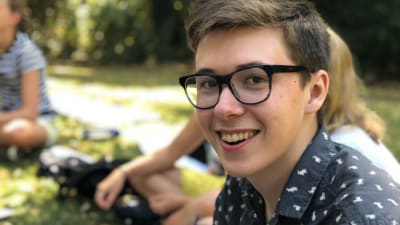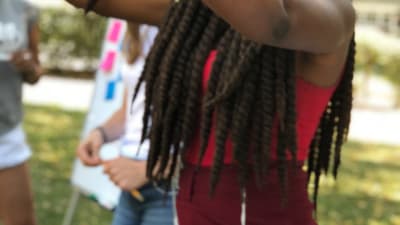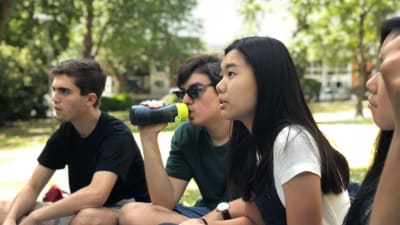Israeli-Palestinian Conflict, Brexit and the EU: SEGL Summer Institute, Week 2
Sometimes world and classroom events align like pedagogical magic. Such was the case last week as we began our study of Brexit and the future of Europe. As Foreign Secretary Boris Johnson and others left Teresa May’s government, and world leaders prepared for the NATO summit, our students were scurrying around London, soaking up knowledge and experience.
On Monday, we introduced the first of three capstone projects, the Social Venture Project. Capstones represent the culminating work of the summer, and successful completion of all three marks one as an SEGL graduate. The “SVP”–a project that has students crafting a social venture they will launch in their home community–allows students to put the skills and knowledge they gained here–public speaking, negotiation, coalition building, persuasive writing, and more–to work immediately. We’re excited to see what these students discover, present, and create.
That afternoon we welcomed Rachel Savage to SEGL’s residence. Ms. Savage is a freelance journalist who most recently worked for The Economist as an Africa correspondent. (She is also a recent winner of The Independent’s Rupert Cornwall Prize.) Savage spoke as part of our British Empire case study. Among other topics, she discussed the lingering cultural artifacts of British Imperialism in day-to-day Kenyan life (the Kenya Colony having lasted until 1963). Students were both collegial and critical in their questions, taking nothing as a given–asking about both negative and positive effects of the British presence in Kenya–and Ms. Savage left impressed.
On Tuesday, we began our Brexit/European Union case study with an introduction to the EU. Students learned about post-World War II Cold War tensions, the 1951 Treaty of Paris, the establishment of the European Steel and Coal Community, and, of course the (sometimes-labyrinthine!) EU itself. Our students, engaged as usual, found themselves asking classic questions of international relations: what responsibility, if any, do countries have to each other? Is it wise to trade some degree of sovereignty for the benefits of a larger, stronger community?
We continued our Brexit/EU studies on Wednesday, when we met with Caroline Morgan, a solicitor (attorney) at the principal UK office of the European Commission–the legislative arm of the EU. In this capacity, she works with EU representatives to draft legislation for Member States. Her focus areas include trade, justice, gender equality, migration, and the European Court of Human Rights. She spoke with our students about the tricky challenge of balancing her British identity–especially at this crucial moment in history–with her work as an employee of the European Union.
Next week, we’ll conclude the Brexit/EU case study with a flourish: a conversation with European Union Member of Parliament Seb Dance.
On Thursday, we presented the second half of SEGL’s Israeli-Palestinian Conflict lecture, covering the Second Intifada, the Camp David II negotiations, and key negotiation “sticking points,” including differences in Israel’s and the Palestinian Authority’s relationship with the U.S. under different presidents. Students were, once again, impressively focused, giving special attention to each others’ personal experiences with the conflict.
The next day, we ended the case study with a visit from Sana Knaneh, a researcher at the Mitvim Israeli Institute for Regional Policy. She spoke about her unique position in the peace process as a Palestinian citizen of Israel; after ensuring our students knew the basics (and being impressed by their knowledge of the history of the conflict), she shared her opinions on the ever-changing prospects for peace. (Knaneh could also help our students with their social venture projects: in 2008, she was named one of Israel’s leading social entrepreneurs!)
Meanwhile, our students gained three additional experiences this week that should improve their understanding of London and themselves.
First, we took more detailed stock of our surroundings (and compared them with our home communities) in an urban planning mini-case study. Stephanie Bothwell (wife of SEGL faculty member James Warren) is a founding member and former trustee of the Congress for a New Urbanism, a leading urban planning organization devoted to walkable, neighborhood-based design. Bothwell, who is also President of the CNU DC board and runs her own design firm, led our students through a mock “charrette” process to redesign the park near their Residence where they often exercise. Students measured the park using their own bodies, after verifying the length of their fingertips, stride, and “wingspan.” Then, with guidance from Bothwell, they took part in a mock Town Hall meeting, playing the roles of common stakeholders in urban design. Some of the choices: “Mother with Young Child” (not to be confused with “Mother with Infant,” who might have different needs), the Principal of a neighboring school, and the Mayor. Students argued for different ways to use the space: gazebos, public bee hives, sports fields, or nothing at all. In the process, they practiced their negotiation and public speaking skills, and gained a new understanding of how intentional design can shape our lives.
Second, students took part in an SEGL classic–the Leadership Styles exercise. With two questions (“Is your first instinct to observe or speak when in a group making a decision?” “When you make important decisions, do you decide with your head or your heart?”) the students divided themselves into four classic leadership styles: Driver, Expressive, Analyst, and Supportive. Each group completed the same given task, but ended up with very different results; the ensuing conversation revealed, among other insights, the importance of having each style reflected in any decision making group (or, perhaps, in any decision making leader!).
Third, we ended our week with a trip to Trafalgar Square, where students spent their afternoon in their choice of the National Portrait Gallery or the National Institute of Art. These museum spaces provide space for practicing observation and reflection skills, and are fast becoming a favorite student pastime.
More to come!

